Comparison of the Laser-Repairing Features of TC4 Titanium Alloy with Different Repaired Layers
Abstract
:1. Introduction
2. Experimental Procedures
2.1. Materials
2.2. Experimental Process
2.3. Analysis Methods
2.4. Numerical Simulation
3. Results
3.1. Initial Parameter Optimization
3.2. Residual Stress
3.3. Microstructure
3.4. Mechanical Properties
4. Conclusions
- The relationship between repairing parameters and repaired formation was explored under a single laser-repairing process. With the increase in laser power, repairing height and width values became larger. With the increase in scanning speed, repairing height and width values became smaller. The repairing height values became larger while the repairing width values varied little under a higher powder feeding rate.
- Optimized parameters obtained under different repaired layers were explored. When the repaired layers were three, laser power was 1100 W, scanning speed was 0.6 m/min and powder feeding rate was 5 g/min. When the repaired layers were five, laser power was 800 W, scanning speed was 0.9 m/min and powder feeding rate was 3.5 g/min.
- The numerical simulation results showed that more repaired layers would result in larger residual stress and repaired deformation. It was found that the von Mises and repairing deformation were 872.6 MPa and 0.20 mm when repaired layers were three while they increased to 911 MPa and 0.26 mm when repaired layers were five.
- With the enhancement of repaired layers, a wider HZA was produced. The microstructures from the TC4 matrix to the repaired area transited from lamellar α phase + intercrystalline β phase—basketweave structure—martensite structure—widmannstatten structure.
- Tensile tests for these two samples showed that ductile fractured models occurred when repaired layers were three and five layers. A higher tensile strength of 910.5 MPa was obtained when repaired layers were three, which resulted from lower residual stress and deformation.
Author Contributions
Funding
Data Availability Statement
Acknowledgments
Conflicts of Interest
References
- Liu, Z.; He, B.; Lyu, T.; Zou, Y. A Review on Additive Manufacturing of Titanium Alloys for Aerospace Applications: Directed Energy Deposition and Beyond Ti-6Al-4V. JOM 2021, 73, 1804–1818. [Google Scholar] [CrossRef]
- Huang, R.; Riddle, M.; Graziano, D.; Warren, J.; Das, S.; Nimbalkar, S.; Cresko, J.; Masanet, E. Energy and Emissions Saving Potential of Additive Manufacturing: The Case of Lightweight Aircraft Components. J. Clean. Prod. 2016, 135, 1559–1570. [Google Scholar] [CrossRef] [Green Version]
- Xia, H.; Li, L.; Tan, C.; Yang, J.; Li, H.; Song, W.; Zhang, K.; Wang, Q.; Ma, N. In Situ SEM Study on Tensile Fractured Behavior of Al/Steel Laser Welding-Brazing Interface. Mater. Des. 2022, 224, 111320. [Google Scholar] [CrossRef]
- Boyer, R.R. An Overview on the Use of Titanium in the Aerospace Industry. Mater. Sci. Eng. A 1996, 213, 103–114. [Google Scholar] [CrossRef]
- Dutta, B.; Froes, F.S. The Additive Manufacturing (AM) of Titanium Alloys. Met. Powder Rep. 2017, 72, 96–106. [Google Scholar] [CrossRef]
- Liu, Q.; Wang, Y.; Zheng, H.; Tang, K.; Li, H.; Gong, S. TC17 Titanium Alloy Laser Melting Deposition Repair Process and Properties. Opt. Laser Technol. 2016, 82, 1–9. [Google Scholar] [CrossRef]
- Zhuang, Z.; Jing, C.; Hua, T.; Xiaolin, Z.; Weidong, H. Microstructure and Mechanical Properties of Laser Repaired TC4 Titanium Alloy. Rare Met. Mater. Eng. 2017, 46, 1792–1797. [Google Scholar] [CrossRef] [Green Version]
- Liu, L.; Du, X.; Zhu, M.; Chen, G. Research on the Microstructure and Properties of Weld Repairs in TA15 Titanium Alloy. Mater. Sci. Eng. A 2007, 445–446, 691–696. [Google Scholar] [CrossRef]
- Yan, L.; Chen, Y.; Liou, F. Additive Manufacturing of Functionally Graded Metallic Materials Using Laser Metal Deposition. Addit. Manuf. 2020, 31, 100901. [Google Scholar] [CrossRef]
- Saboori, A.; Aversa, A.; Marchese, G.; Biamino, S.; Lombardi, M.; Fino, P. Application of Directed Energy Deposition-Based Additive Manufacturing in Repair. Appl. Sci. 2019, 9, 3316. [Google Scholar] [CrossRef] [Green Version]
- Ünal-Saewe, T.; Gahn, L.; Kittel, J.; Gasser, A.; Schleifenbaum, J.H. Process Development for Tip Repair of Complex Shaped Turbine Blades with IN718. Procedia Manuf. 2020, 47, 1050–1057. [Google Scholar] [CrossRef]
- Ren, Y.M.; Lin, X.; Fu, X.; Tan, H.; Chen, J.; Huang, W.D. Microstructure and Deformation Behavior of Ti-6Al-4V Alloy by High-Power Laser Solid Forming. Acta Mater. 2017, 132, 82–95. [Google Scholar] [CrossRef]
- Wang, W.; Wang, M.; Jie, Z.; Sun, F.; Huang, D. Research on the Microstructure and Wear Resistance of Titanium Alloy Structural Members Repaired by Laser Cladding. Opt. Lasers Eng. 2008, 46, 810–816. [Google Scholar] [CrossRef]
- Yang, Y.-P.; Babu, S.S. An Integrated Model to Simulate Laser Cladding Manufacturing Process for Engine Repair Applications. Weld World 2010, 54, R298–R307. [Google Scholar] [CrossRef]
- Azarniya, A.; Colera, X.G.; Mirzaali, M.J.; Sovizi, S.; Bartolomeu, F.; Wits, W.W.; Yap, C.Y.; Ahn, J.; Miranda, G.; Silva, F.; et al. Additive Manufacturing of Ti–6Al–4V Parts through Laser Metal Deposition (LMD): Process, Microstructure, and Mechanical Properties. J. Alloys Compd. 2019, 804, 163–191. [Google Scholar] [CrossRef]
- Liu, S.; Shin, Y.C. Additive Manufacturing of Ti6Al4V Alloy: A Review. Mater. Des. 2019, 164, 107552. [Google Scholar] [CrossRef]
- Wu, X.; Liang, J.; Mei, J.; Mitchell, C.; Goodwin, P.S.; Voice, W. Microstructures of Laser-Deposited Ti–6Al–4V. Mater. Des. 2004, 25, 137–144. [Google Scholar] [CrossRef]
- Shipley, H.; McDonnell, D.; Culleton, M.; Coull, R.; Lupoi, R.; O’Donnell, G.; Trimble, D. Optimisation of Process Parameters to Address Fundamental Challenges during Selective Laser Melting of Ti-6Al-4V: A Review. Int. J. Mach. Tools Manuf. 2018, 128, 1–20. [Google Scholar] [CrossRef]
- Zhao, H.; Yu, C.; Liu, Z.; Liu, C.; Zhan, Y. A Novel Finite Element Method for Simulating Residual Stress of TC4 Alloy Produced by Laser Additive Manufacturing. Opt. Laser Technol. 2023, 157, 108765. [Google Scholar] [CrossRef]
- Goldak, J.; Chakravarti, A.; Bibby, M. A New Finite Element Model for Welding Heat Sources. Metall. Trans. B 1984, 15, 299–305. [Google Scholar] [CrossRef]
- Lin, C.-M. Parameter Optimization of Laser Cladding Process and Resulting Microstructure for the Repair of Tenon on Steam Turbine Blade. Vacuum 2015, 115, 117–123. [Google Scholar] [CrossRef]
- Liu, S.; Liu, J.; Chen, J.; Liu, X. Influence of Surface Tension on the Molten Pool Morphology in Laser Melting. Int. J. Therm. Sci. 2019, 146, 106075. [Google Scholar] [CrossRef]
- Fang, J.X.; Dong, S.Y.; Li, S.B.; Wang, Y.J.; Xu, B.S.; Li, J.; Liu, B.; Jiang, Y.L. Direct Laser Deposition as Repair Technology for a Low Transformation Temperature Alloy: Microstructure, Residual Stress, and Properties. Mater. Sci. Eng. A 2019, 748, 119–127. [Google Scholar] [CrossRef]
- Paydas, H.; Mertens, A.; Carrus, R.; Lecomte-Beckers, J.; Tchuindjang, J.T. Laser Cladding as Repair Technology for Ti–6Al–4V Alloy: Influence of Building Strategy on Microstructure and Hardness. Mater. Des. 2015, 85, 497–510. [Google Scholar] [CrossRef]
- Kelly, S.M. Thermal and Microstructure Modeling of Metal Deposition Processes with Application to Ti-6Al-4V; Virginia Tech: Blacksburg, VA, USA, 2004. [Google Scholar]
- Cottam, R.; Brandt, M. Laser Cladding of Ti-6Al-4 V Powder on Ti-6Al-4 V Substrate: Effect of Laser Cladding Parameters on Microstructure. Phys. Procedia 2011, 12, 323–329. [Google Scholar] [CrossRef] [Green Version]
- Wang, Y.; Ma, H.; Zhang, Y. Effect of the Notch Depth on Fracture Behavior of TC4 Titanium Alloy Sheets. Eng. Fract. Mech. 2023, 277, 108947. [Google Scholar] [CrossRef]



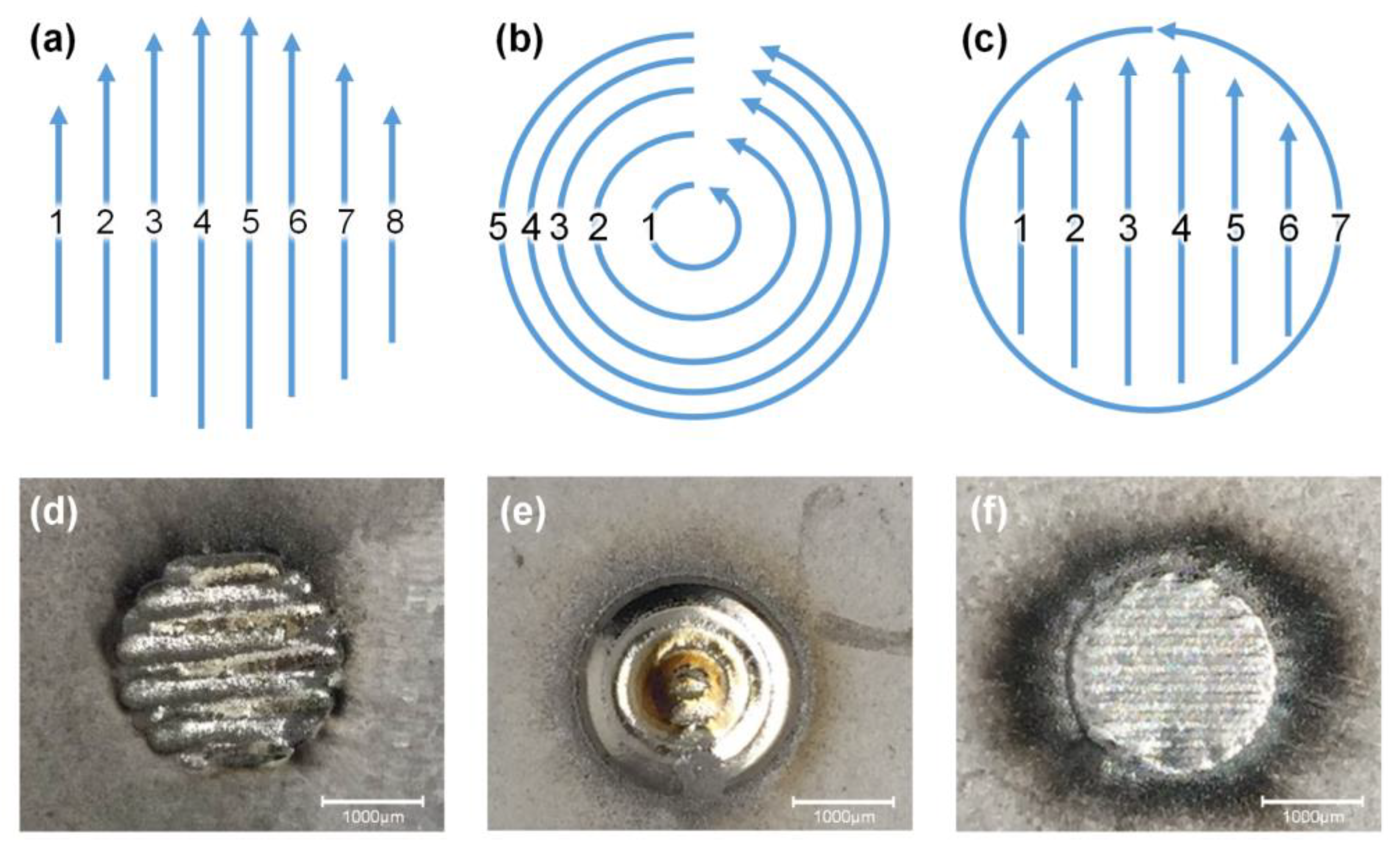


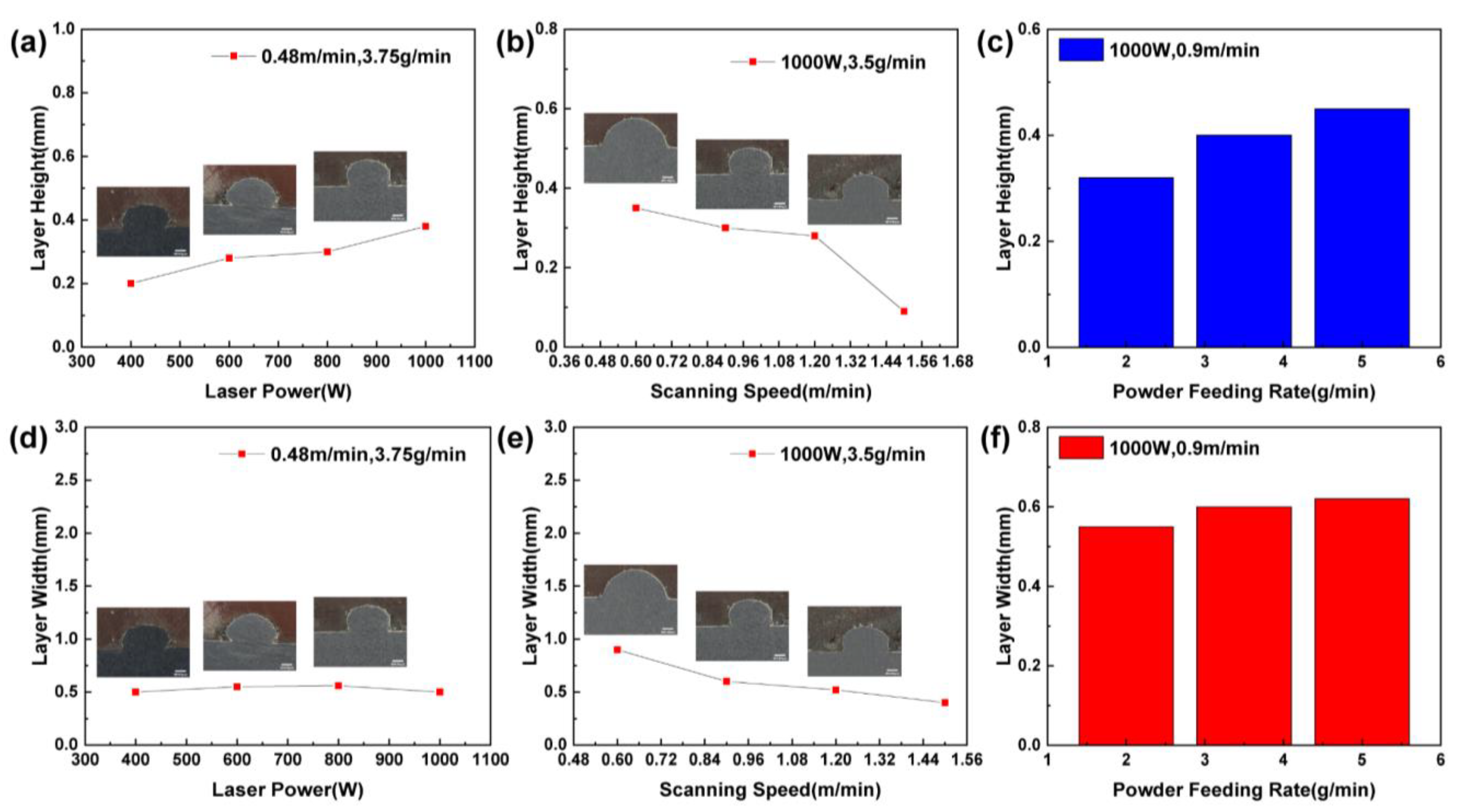
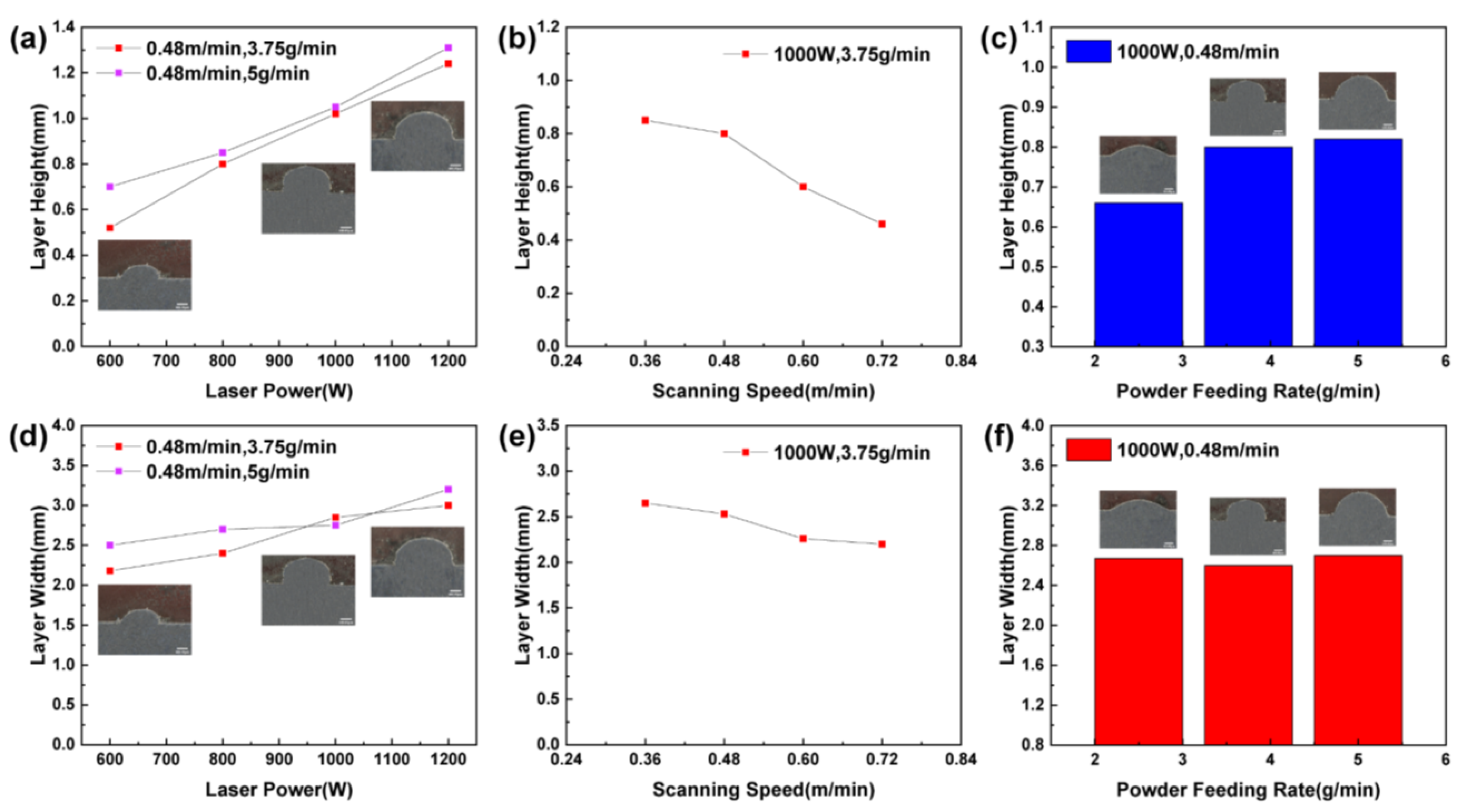

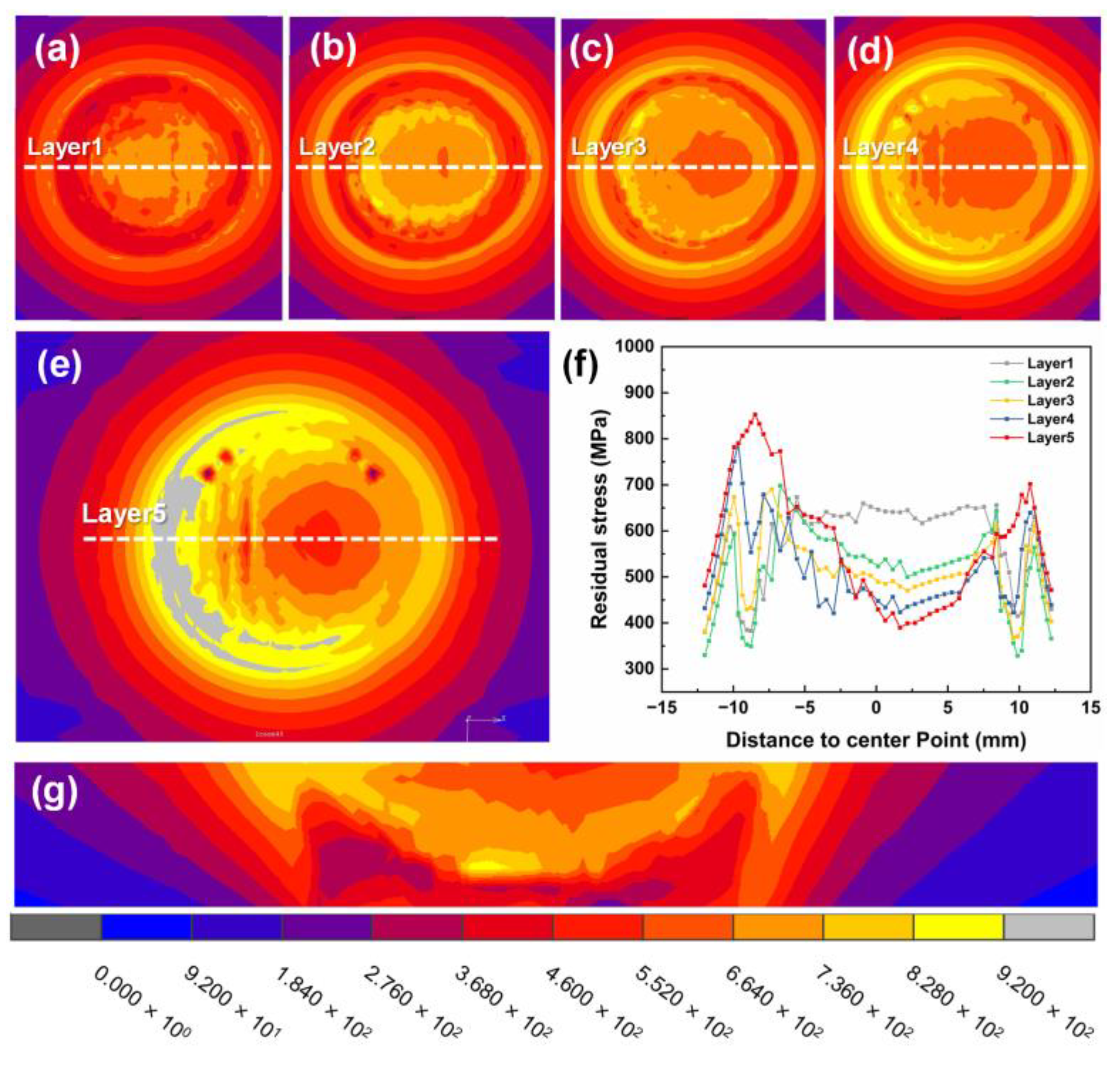
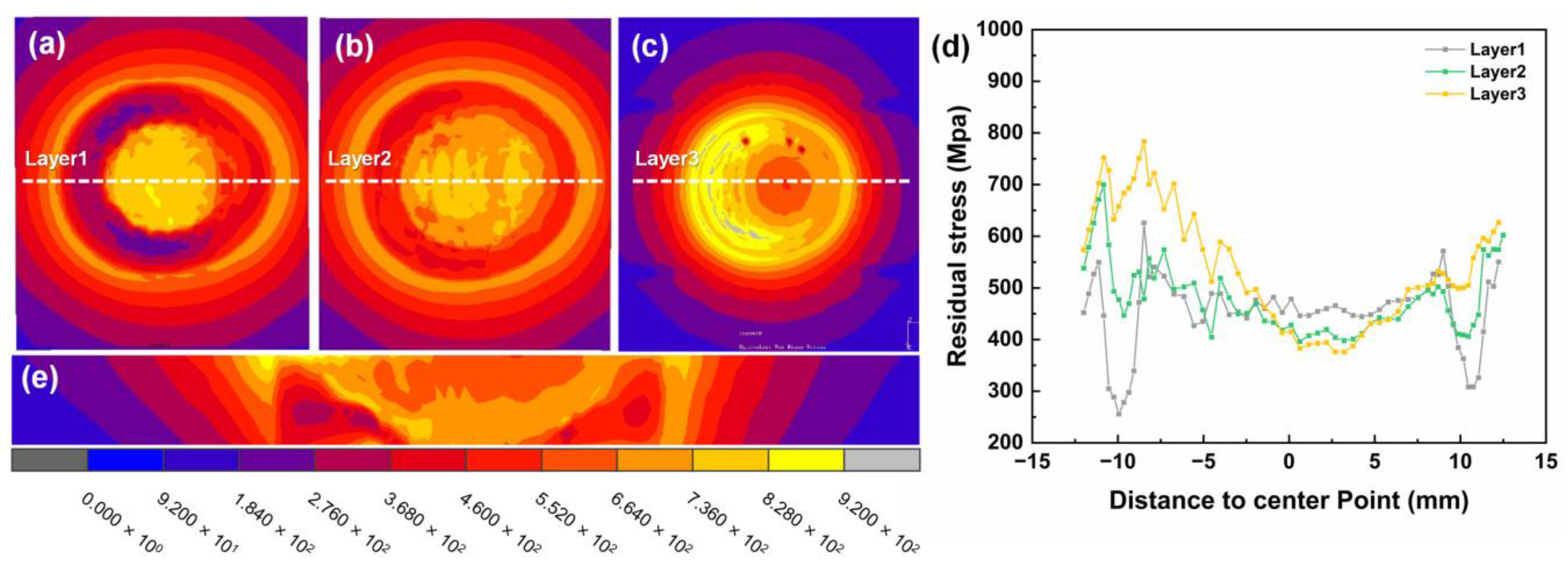
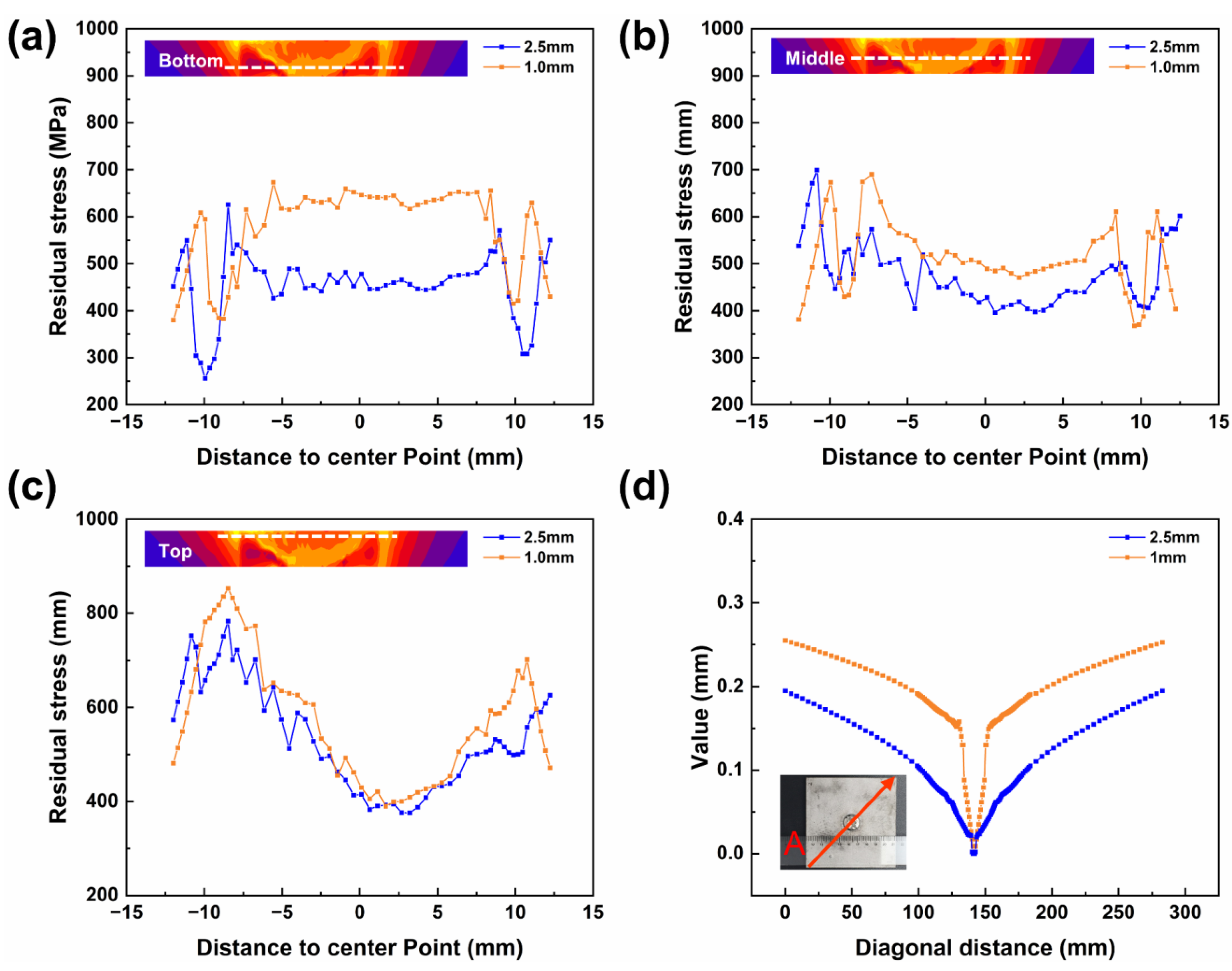
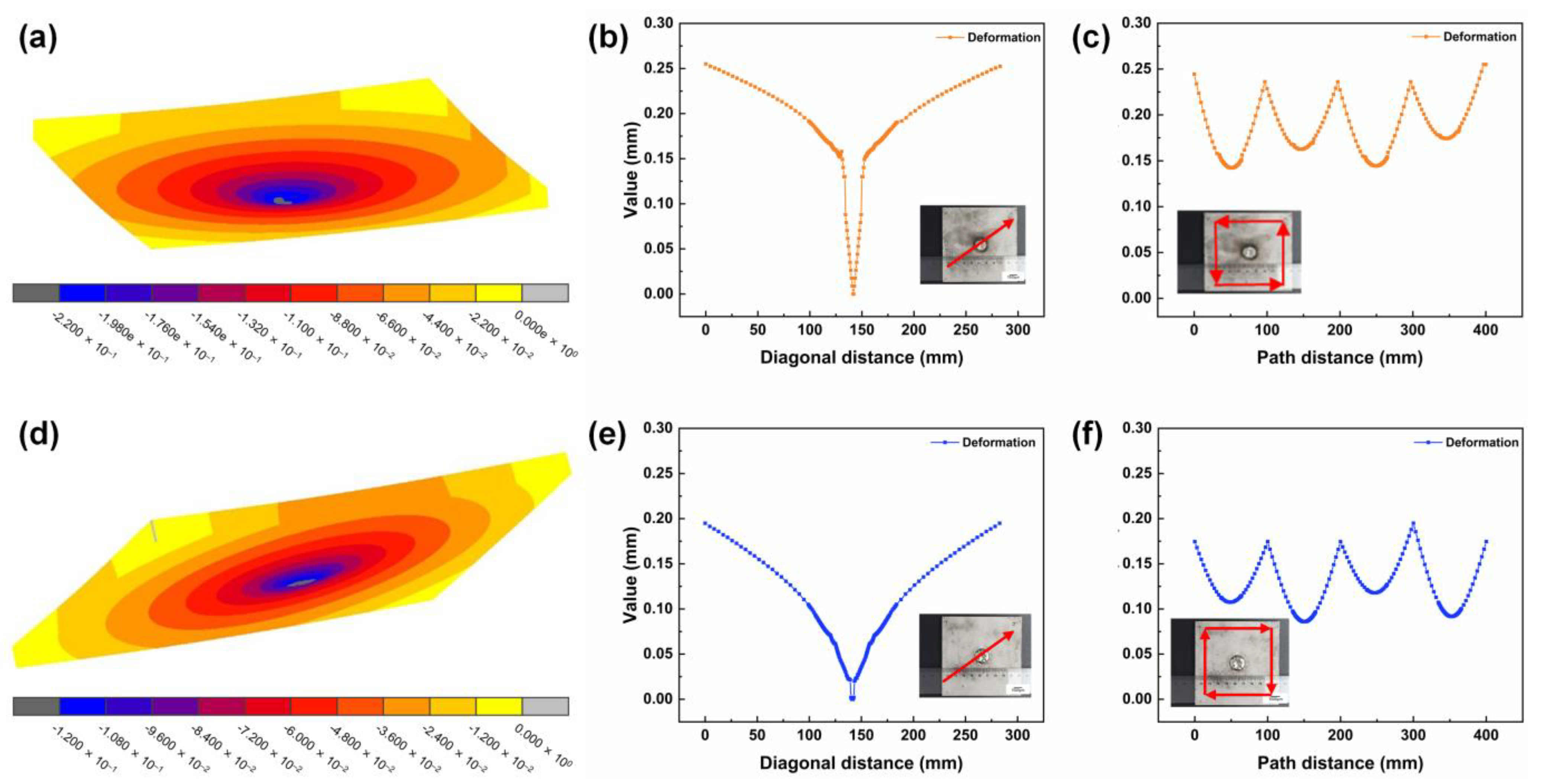

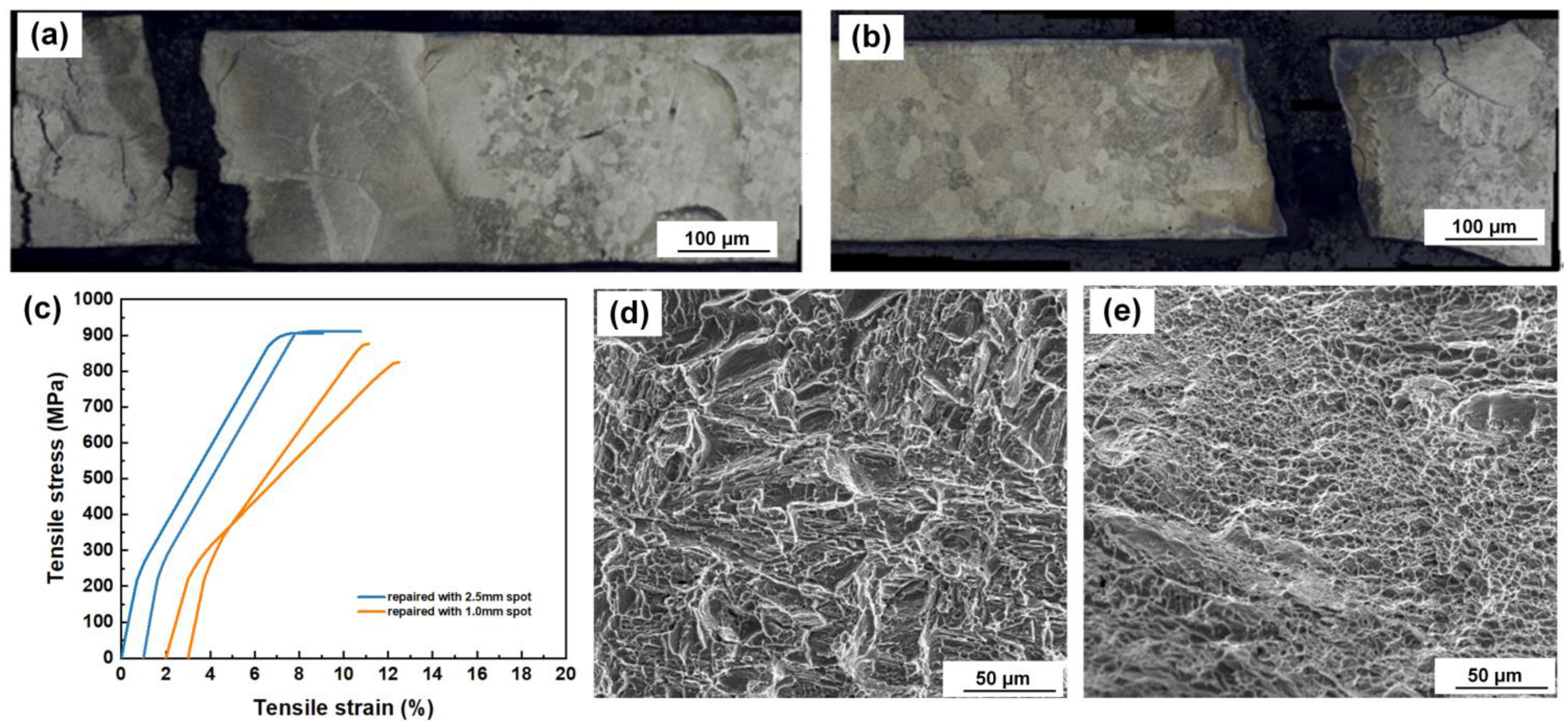
| Element | Al | V | Fe | C | O | N | H | Ti |
|---|---|---|---|---|---|---|---|---|
| TC4 | 6.1% | 4.05% | 0.30% | 0.01% | 0.02% | 0.03% | 0.005% | Margin |
| Adopted Parameters | 2.5 mm Laser Diameter | 1.0 mm Laser Diameter |
|---|---|---|
| Laser power | 800 W | 1100 W |
| Scanning speed | 0.5 m/min | 0.6 m/min |
| Powder feeding speed | 9.0 L/min | 9.0 L/min |
| Defocused distance, mm | +20 | +20 |
| Flowing volume of protecting gas, L/min | 15 | 15 |
| Temperature (°C) | Specific Heat (J · kg−1·°C−1) | Thermal Conductivity (W·m−1·°C−1) | Linear Expansion Coefficient (10−6 °C−1) | Yong’s Modulus (GPa) | Yield Strength (MPa) | Passion Rate |
|---|---|---|---|---|---|---|
| 75 | 549.67 | 5.14 | 8.90 | 116.05 | 820 | 0.32 |
| 85 | 551.69 | 5.27 | 8.90 | 115.79 | 750 | 0.32 |
| 100 | 555.57 | 5.52 | 8.93 | 115.27 | 340 | 0.32 |
| 200 | 572.58 | 6.71 | 9.08 | 112.66 | 130 | 0.32 |
| 300 | 589.62 | 7.99 | 9.26 | 109.50 | 90 | 0.32 |
| 500 | 616.11 | 10.09 | 9.59 | 103.68 | 66 | 0.33 |
| 800 | 652.10 | 13.03 | 10.10 | 94.57 | 31 | 0.33 |
| 1000 | 675.07 | 14.83 | 10.40 | 88.60 | 12 | 0.34 |
| 1200 | 699.68 | 16.59 | 10.70 | 82.57 | 2 | 0.34 |
| 1500 | 872.09 | 19.52 | 10.80 | 74.27 | 0.1 | 0.35 |
| No. | Laser Power | Scanning Speed | Powder Feeding Rate | Cladding Formation |
|---|---|---|---|---|
| 1 | 400 W | 0.9 m/min | 2 g/min |  |
| 2 | 600 W | 0.9 m/min | 3.5 g/min |  |
| 3 | 700 W | 0.9 m/min | 3.5 g/min |  |
| 4 | 800 W | 0.9 m/min | 3.5 g/min |  |
| 5 | 900 W | 0.9 m/min | 3.5 g/min |  |
| 6 | 900 W | 1.2 m/min | 3.5 g/min |  |
| No. | Laser Power | Scanning Speed | Powder Feeding Rate | Cladding Formation |
|---|---|---|---|---|
| 1 | 700 W | 1.2 m/min | 5 g/min |  |
| 2 | 700 W | 0.6 m/min | 2.5 g/min |  |
| 3 | 700 W | 0.6 m/min | 5 g/min |  |
| 4 | 900 W | 0.6 m/min | 5 g/min |  |
| 5 | 1000 W | 0.6 m/min | 5 g/min |  |
| 6 | 1100 W | 0.6 m/min | 5 g/min |  |
| 7 | 1200 W | 0.6 m/min | 5 g/min |  |
| NO. | Laser Power | Scanning Speed | Powder Feeding Rate | Diameter of Laser Spot | Defocused Distance | Powder Feed Gas (L/min) | Shield Gas |
|---|---|---|---|---|---|---|---|
| 1 | 1100 W | 0.6 m/min | 5 g/min | 2.5 mm | 0.6 mm | 9 L/min | 15 L/min |
| 2 | 800 W | 0.9 m/min | 3.5 g/min | 1.0 mm | 0.4 mm | 9 L/min | 15 L/min |
Disclaimer/Publisher’s Note: The statements, opinions and data contained in all publications are solely those of the individual author(s) and contributor(s) and not of MDPI and/or the editor(s). MDPI and/or the editor(s) disclaim responsibility for any injury to people or property resulting from any ideas, methods, instructions or products referred to in the content. |
© 2023 by the authors. Licensee MDPI, Basel, Switzerland. This article is an open access article distributed under the terms and conditions of the Creative Commons Attribution (CC BY) license (https://creativecommons.org/licenses/by/4.0/).
Share and Cite
Qie, X.; Li, L.; Guo, P.; Huang, Y.; Zhou, J. Comparison of the Laser-Repairing Features of TC4 Titanium Alloy with Different Repaired Layers. Crystals 2023, 13, 438. https://doi.org/10.3390/cryst13030438
Qie X, Li L, Guo P, Huang Y, Zhou J. Comparison of the Laser-Repairing Features of TC4 Titanium Alloy with Different Repaired Layers. Crystals. 2023; 13(3):438. https://doi.org/10.3390/cryst13030438
Chicago/Turabian StyleQie, Xiwang, Liqun Li, Pengfei Guo, Yichen Huang, and Jianxin Zhou. 2023. "Comparison of the Laser-Repairing Features of TC4 Titanium Alloy with Different Repaired Layers" Crystals 13, no. 3: 438. https://doi.org/10.3390/cryst13030438





